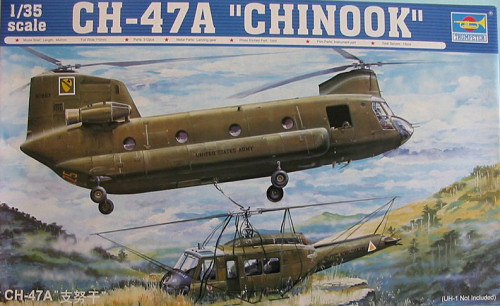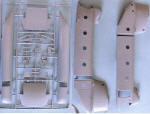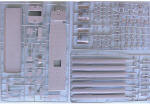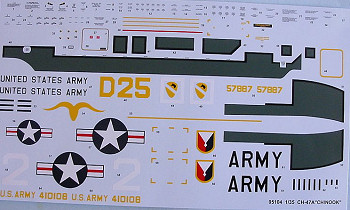
| KIT: | Trumpeter 1/35 CH-47A Chinook |
| KIT #: | 5104 |
| PRICE: | $140.00 MSRP |
| DECALS: | Two options |
| REVIEWER: | Tom Cleaver |
| NOTES: |

| HISTORY |
It’s hard to believe, but the CH-47 Chinook in its many derivatives is going on 50 years old, having appeared as a prototype design in 1956. This helicopter has now served operationally for more than 40 years, having first gone to Vietnam with the 1st Cavalry (Airmobile) Division in 1965.
Helicopter pioneer Frank Piasecki was the designer who created what were called “flying bananas,” tandem-rotor helicopters designed for heavy lift. He left his company in 1955 to create a new company. The original changed its name to Vertol, and began development of what would become the CH-46 and CH-47 helicopters the next year. Running short of cash for further development of what already appeared to be very promising designs, the company was bought by Boeing in 1960, becoming Boeing-Vertol, and later Boeing Helicopters.
Vertol’s 1956 study was for a new medium-lift helicopter with the general configuration of the company's HUP-1 “Retriever”/H-25 “Mule" helicopter, using the rotor system of the company's H-21 “Flying Banana.” Rather than using the heavy radial engines these helicopters were powered by, the design was to use the new lightweight turboshaft engines then being developed. The design was given the company designation "Vertol Model 107 (V-107)," and was promising enough that company management decided to go ahead with development without waiting for a government contract.
The V-107 prototype was powered by two Lycoming T53 turboshaft engines of 860 horsepower provided the US Army. The first flight came on April 22, 1958, and was put through an intensive program of flight demonstrations in the U.S. and overseas, which resulted in an Army contract in June 1958 for ten production aircraft designated "YHC-1A". Shortly thereafter, the Army issued a Request for Proposals for a larger helicopter. Vertol responded with a scaled up version of the V-107, the "V-114". The V-114 won, and Vertol received a contract for a mockup and five prototypes, designated the "YHC-1B".
It was at this point, with Vertol now trying to develop two helicopters at the same time, that the Boeing buyout happened. The YHC-1A prototypes were reduced to three to free up resources for YHC-1B development, with the first flight of the YHC-1B prototype on September 21, 1961.
Following comparison of the two, the Army lost in the YHC-1A and decided to concentrate on the YHC-1B. At this point, Vertol got the Marines interested in the first design, which went on to become the CH-46 Sea Knight, which still serves the Corps 40 years later.
In 1962, with the change in service designations to a single system, the YHC-1B became the YH-47A and was given the name “Chinook,” following the Army system of giving helicopters the name of Native American tribes.
The first CH-47A Chinook was delivered to the US Army in August 1962. The helicopter had a contra-rotating tandem-rotor configuration, the two 2,200 horsepower Lycoming T55-L-5 turboshafts mounted on each side of the rear rotor pedestal, with a driveshaft running up the top of the fuselage to the forward rotor and the capability of one engine driving both rotors in an emergency. The engines were shortly changed to the T55-L-7 with 2,650 horsepower. The three-bladed rotors were high enough for personnel to walk under them safely, and could be manually folded. The aircraft had a rear loading ramp that could be set to any level, to allow loading from trucks or other platforms, and could be opened in flight for dropping paratroops or parachute loads. A winch system was provided in the cargo bay to help handle loads, which were secured with deck tie-point points. A single sling attachment was fitted in the belly. Fairings containing the fuel tanks ran most of the length of the fuselage, and there were four fixed landing gear. As with the CH-46, the wheels could be fitted with skis for operation on snow or marshy ground, and the helicopter could land on calm waters in an emergency. The useful load was 33 fully-equipped troops on sidewall seating or 24 casualty litters with two attendants, or 6,000 pounds of internal cargo, while up to 13,000 pounds of cargo could be lifted externally.
Production of the CH-47A totaled 354, and the Chinook first went to Vietnam in 1965, where it served with distinction, particularly in retrieving downed aircraft from field locations and carrying stores, ammunition, and artillery pieces to remote firebases. The Chinook soon proved to be such an invaluable aircraft for artillery movement and heavy logistics that it was seldom used as an assault troop carrier.
The CH-47A was limited by its rotor system, which did not permit full use of the installed power. The first attempt to deal with this was the CH-47B, equipped with 2,850 horsepower Lycoming T55-L-7C turboshafts and slightly longer, redesigned rotor blades. Externally, strakes were fitted alongside the rear loading ramp to improve flight stability, a feature retained in later Chinook models. The CH-47C - the last major new production variant for the US Army - was equipped with 3,750 horsepower Lycoming T55-L-11 engines and a more robust power transmission system to support the greater power, that allowed the CH-47C to carry the M198 155 millimeter howitzer without trouble and at a substantially higher speed than its predecessors.
The CH-47D update program began in 1976, with the prototype’s first flight on May 14, 1979 and the first flight of a production CH-47D on February 26, 1982. 403 CH-47As, CH-47Bs, and CH-47Cs, were upgraded to "CH-47D" specification, which features a refurbished airframe with some composite assemblies; single-point pressure refueling; an improved rotor transmission; fiberglass rotor blades; and Garrett T55-L-712 turboshafts of 3,750 horsepower.
The large Chinook fleet remains the backbone of the Army’s medium-lift capability, and has served in all operations since Vietnam. The CH-47 has been used for fire-fighting with a sling-carried kit, and even for transporting the Apollo Lunar Module from the Grumman plant in Tulsa, Oklahoma, to Cape Canaveral. In 2006, it shows no signs of phase-out, and is used by several other armed forces and civilian operators around the world.
| THE KIT |
 Not being a big
helicopter fan, I have to say I am not sure what other kits there are of the
Chinook, but it’s for certain no other exists in 1/35 scale. Trumpeter’s
decision to make their helicopters in the popular military scale insures ease in
creating some very spectacular Vietnam dioramas with this kit.
Not being a big
helicopter fan, I have to say I am not sure what other kits there are of the
Chinook, but it’s for certain no other exists in 1/35 scale. Trumpeter’s
decision to make their helicopters in the popular military scale insures ease in
creating some very spectacular Vietnam dioramas with this kit.
I would say that, with this kit and the big Tu-160 following on to the Me-262 and A-7E kits - all of which have state-of-the-art surface detailing and excellent parts fit - that Trumpeter can be said to have “arrived”. No longer is it a question of “iffy” design and a rollercoaster of accuracy from kit to kit.
 The Chinook kit consists
of 260 parts on eight sprues, and includes photo-etch wire screen for the engine
nacelles and photo-etch seat belts. While the interior does not have any seats,
the fact is that most Chinooks never operated with seats as it is, being used
primarily as cargo haulers in which passengers perch themselves as best they can
on what’s there. The cockpit is nicely detailed out of the box, though I am
sure purists will look for a company like Cobra to come along with “definitive”
cockpit sets in resin.
The Chinook kit consists
of 260 parts on eight sprues, and includes photo-etch wire screen for the engine
nacelles and photo-etch seat belts. While the interior does not have any seats,
the fact is that most Chinooks never operated with seats as it is, being used
primarily as cargo haulers in which passengers perch themselves as best they can
on what’s there. The cockpit is nicely detailed out of the box, though I am
sure purists will look for a company like Cobra to come along with “definitive”
cockpit sets in resin.
 While I am no
helicopter “experte,” this looks accurate to me, and can likely be made as any
early-model Chinook, with mot people not noticing the slight difference in rotor
diameter from the A model to later versions. In fact, I don’t really know if
the rotor isn’t already correct for the later versions or the updated A model.
(Editor's note: I've just shown a few of the representative sprues on this one).
While I am no
helicopter “experte,” this looks accurate to me, and can likely be made as any
early-model Chinook, with mot people not noticing the slight difference in rotor
diameter from the A model to later versions. In fact, I don’t really know if
the rotor isn’t already correct for the later versions or the updated A model.
(Editor's note: I've just shown a few of the representative sprues on this one).
My only complaint about the kit is that the markings for the early A model have full-color US National Insignia that are completely useless. How it is that after 50 years of making decals of a national insignia in which the dimensions are widely known, that people can still “screw the pooch” on this is beyond me. However, most people are going to opt for at least a “Vietnam version” in which the national insignia isn’t used, so this is a very minor point.
| CONCLUSIONS |
While I freely admit that helicopters are the one flying machine I don’t really like (stemming from a “bad experience” early on), some of them are interesting to me, and the Chinook is one of those, so I am looking forward to the project as more than just a review. This kit looks like it will build up into an impressive model, without a lot of difficulty so long as a modeler takes the radical step of actually following the well-thought-out instructions. It will be a model where pre-shading, post-shading, sun-fading, and other artistic touches with the airbrush will be important in turning it into something besides a big lump of Olive Drab.
February 2006
Thanks to Stevens International for the review kit.
If you would like your product reviewed fairly and quickly by a site that has over 300,000 visitors a month, please contact me or see other details in the Note to Contributors.